Brentford: Difference between revisions
Created page with '{{Infobox town | name = Brentford | county = Middlesex | picture=Brentford skyline.JPG | picture caption=Skyline over Brentford town centre | os grid ref= TQ177778 | latitude = 5…' |
mNo edit summary |
||
| (4 intermediate revisions by 3 users not shown) | |||
| Line 2: | Line 2: | ||
| name = Brentford | | name = Brentford | ||
| county = Middlesex | | county = Middlesex | ||
| picture= | | picture=Brentford_skyline.JPG | ||
| picture caption=Skyline over Brentford town centre | | picture caption=Skyline over Brentford town centre | ||
| os grid ref= TQ177778 | | os grid ref= TQ177778 | ||
| Line 18: | Line 18: | ||
In 1795 New Brentford was considered as the county-town, but the justices of Middlesex met in [[Clerkenwell]]. Pevsner noted that Brentford possessed no town-hall or other public building. | In 1795 New Brentford was considered as the county-town, but the justices of Middlesex met in [[Clerkenwell]]. Pevsner noted that Brentford possessed no town-hall or other public building. | ||
Brentford's main visible landmark to passers by is the "Minaret", part of the Grand Union Waterworks by the Thames. | |||
==Two towns== | ==Two towns== | ||
| Line 23: | Line 25: | ||
'''New Brentford''' has also been called West Brentford or Great Brentford, and lies to the west of Old Brentford, standing on each side of the Brent. The modern town north of the High Street has developed from New Brentford. | '''New Brentford''' has also been called West Brentford or Great Brentford, and lies to the west of Old Brentford, standing on each side of the Brent. The modern town north of the High Street has developed from New Brentford. | ||
The two towns have long since merged and in turn been swallowed into the London conurbation, but they retain separate town centres. Brentford's heart spreads along the main road, now the A3. Its heart and origin are the docks where the River Brent enters the Thames, and the Market Square of Old Brentford. | |||
Brentford has undergone a revival since the 1990s. The lands around Brentford dock have seen new development and commercial life and the town is lively. | |||
== History == | == History == | ||
| Line 30: | Line 36: | ||
[[File:Thames Lock, Brentford, Spring Tide, Twilight, 20050113.jpg|thumb|The Thames Lock on the Grand Union Canal at Brentford]] | [[File:Thames Lock, Brentford, Spring Tide, Twilight, 20050113.jpg|thumb|The Thames Lock on the Grand Union Canal at Brentford]] | ||
Brentford is said to be where Julius Caesar forded the Thames in his second raid on Britain.<ref>Sir Montagu Sharpe</ref> This location is asserted on the Brentford Monument, and that a battle was fought here between Cæsar's forces and Cassivellaunus, King of the Trinovantes.<ref>[http://www.thomaslayton.org.uk/joomla/index.php?option=com_content&task=view&id=36&Itemid=42 The Thomas Layton Collection, Inscription on the Brentford Monument]</ref> There are, however, two other historically accredited ''battles of Brentford'' in 1016 and 1642In the twentieth century a hefty stake was found in the river, possibly one of those which Roman historians report were driven into the river by the Britons to hinder the Romans. The stake forms part of the Middlesex Guildhall Collection. | |||
In Saxon times the Church held a major synod in Brentford. In later times it prospered as a river harbour, the mouth of the Brent providing a haven on the Thames and a conduit inland for boats. | |||
=== Timeline === | === Timeline === | ||
| Line 53: | Line 61: | ||
*1965 Opening of elevated section of M4 motorway | *1965 Opening of elevated section of M4 motorway | ||
The road which is now Brentford High Street served as the main road to the South West of Britain for many centuries, and even now, the M4 motorway and the Great West Road pass approximately | The road which is now Brentford High Street served as the main road to the South West of Britain for many centuries, and even now, the M4 motorway and the Great West Road pass approximately a mile north of the original main road through Brentford. | ||
== The Hardwicks == | == The Hardwicks == | ||
| Line 77: | Line 85: | ||
[[File:Pool of Brentford Lock.jpg|thumb|right|200px|The Pool of Brentford Lock with new developments]] | [[File:Pool of Brentford Lock.jpg|thumb|right|200px|The Pool of Brentford Lock with new developments]] | ||
'''Syon Park House''' (demolished in 1953), not to be confused with Syon House, housed the 'Syon Park Academy' where the poet Shelley was educated between the ages of 10 and 12 before moving on to Eton College. A Royal Mail depot stands on the site now. This may also be the site of the dwelling where Pocahontas lived in Brentford End between 1616 and 1617. | '''Syon Park House''' (demolished in 1953), not to be confused with Syon House, housed the 'Syon Park Academy' where the poet Shelley was educated between the ages of 10 and 12 before moving on to [[Eton College]]. A Royal Mail depot stands on the site now. This may also be the site of the dwelling where Pocahontas lived in Brentford End between 1616 and 1617. | ||
'''Brentford Dock''', a freight terminus of the Great Western Railway, built at the confluence of the River Thames and River Brent, designed by Isambard Kingdom Brunel, and built between 1855 and 1859. A spur line from the GWR at Southall was constructed to the Brentford Dock railway station to facilitate easy transferral of freight from lighter (barge)|lighters and barges on the Thames to GWR-served destinations in the west of the United Kingdom. The dock was redeveloped as residential accommodation in the early 1970s, and little industrial archaeology remains. However, Dock Road still retains some of its original fan pattern cobblestone road bed and examples of Brunel's broad-gauge 'bridge section' rail can be seen there. | '''Brentford Dock''', a freight terminus of the Great Western Railway, built at the confluence of the River Thames and River Brent, designed by Isambard Kingdom Brunel, and built between 1855 and 1859. A spur line from the GWR at Southall was constructed to the Brentford Dock railway station to facilitate easy transferral of freight from lighter (barge)|lighters and barges on the Thames to GWR-served destinations in the west of the United Kingdom. The dock was redeveloped as residential accommodation in the early 1970s, and little industrial archaeology remains. However, Dock Road still retains some of its original fan pattern cobblestone road bed and examples of Brunel's broad-gauge 'bridge section' rail can be seen there. | ||
| Line 98: | Line 106: | ||
'''Griffin Park''' is home to Brentford Football Club and Chelsea Football Club Reserves (from 2002 until 23 September 2005 it was the home of the London Broncos rugby league club - subsequently they were renamed Harlequins Rugby League and transferred to The Stoop). | '''Griffin Park''' is home to Brentford Football Club and Chelsea Football Club Reserves (from 2002 until 23 September 2005 it was the home of the London Broncos rugby league club - subsequently they were renamed Harlequins Rugby League and transferred to The Stoop). | ||
[[File:Brentford-houseboats-5840.jpg|thumb|right|240px|Houseboats on the Thames at Brentford, from Kew Bridge]] | [[File:Brentford-houseboats-5840.jpg|thumb|right|240px|Houseboats on the Thames at Brentford, from Kew Bridge]] | ||
== Outside links == | == Outside links == | ||
{{commons}} | |||
*[http://www.syonpark.co.uk Syon Park and House] | *[http://www.syonpark.co.uk Syon Park and House] | ||
*[http://www.hounslow.info/parks/boston/index.htm Boston Manor Park] | *[http://www.hounslow.info/parks/boston/index.htm Boston Manor Park] | ||
| Line 121: | Line 123: | ||
*[http://www.brentford.inuk.com/ Amateur local history website on Brentford] | *[http://www.brentford.inuk.com/ Amateur local history website on Brentford] | ||
*[http://www.bhsproject.co.uk/ Brentford High Street project: people and properties 1840 - 1940] | *[http://www.bhsproject.co.uk/ Brentford High Street project: people and properties 1840 - 1940] | ||
== References== | |||
{{Reflist}} | |||
*The Archive Photographs Series, Brentford; Tempus Publishing Ltd., 1998, ISBN 0-7524-0627-2 | |||
*Brentford as it was; Hendon Publishing Co. Ltd., Second impression May 1993, ISBN 0-86067-082-1 | |||
*Brentford Past; Historical Publications Ltd., ISBN 0-948667-79-6 | |||
*Old Ordnance Survey Maps, Brentford 1894, The Godfrey Edition; Alan Godfrey Maps, ISBN 0-85054-509-9 | |||
Latest revision as of 14:51, 10 January 2020
| Brentford | |
| Middlesex | |
|---|---|
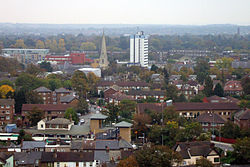 Skyline over Brentford town centre | |
| Location | |
| Grid reference: | TQ177778 |
| Location: | 51°29’10"N, 0°18’36"W |
| Data | |
| Post town: | Brentford |
| Postcode: | TW8 |
| Dialling code: | 020 |
| Local Government | |
| Council: | Hounslow |
| Parliamentary constituency: |
Brentford and Isleworth |
Brentford is a suburban town in Middlesex where the River Brent enters the River Thames.
New Brentford has been described as the county town of Middlesex. It was so described in 1789, on the basis that elections of the county's two Members of Parliament took place in Brentford from 1701.[1][2] The elections took place at The Butts, then a substantial open space, originally the place where parish archery practice took place. As in other counties, the electors gathered and over the course of the day or often a number of days, each mounted a platform, the hustings, and declared his vote. The most famous county election here was in 1769, a lively affair in which John Wilkes was elected, though the House of Commons rejected him (a scandal which has never been repeated).
In 1795 New Brentford was considered as the county-town, but the justices of Middlesex met in Clerkenwell. Pevsner noted that Brentford possessed no town-hall or other public building.
Brentford's main visible landmark to passers by is the "Minaret", part of the Grand Union Waterworks by the Thames.
Two towns
Old Brentford is the part of Brentford lying to the east of the River Brent and at its mouth. It was the original village.
New Brentford has also been called West Brentford or Great Brentford, and lies to the west of Old Brentford, standing on each side of the Brent. The modern town north of the High Street has developed from New Brentford.
The two towns have long since merged and in turn been swallowed into the London conurbation, but they retain separate town centres. Brentford's heart spreads along the main road, now the A3. Its heart and origin are the docks where the River Brent enters the Thames, and the Market Square of Old Brentford.
Brentford has undergone a revival since the 1990s. The lands around Brentford dock have seen new development and commercial life and the town is lively.
History
Brentford, as the name suggests, was built on a fording point on the River Brent. At the time of the Council of Brentford 781 and later in the Anglo-Saxon Chronicle the town is named as Bregentford (pronounded much as the town’s name is pronounced today), becoming Brentford by 1016. The root Bregent, for the river is of unknown origin; some have suggested an origin in the name of a Celtic goddess Brigantia, though closer Anglo-Saxon origins seem less fanciful.
The settlement pre-dates the Roman occupation of Britain. Many pre-Roman artefacts have been excavated in and around the area in Brentford known as 'Old England'. Bronze Age pottery and burnt flints have been found in separate sites in Brentford. The quality and quantity of the artefacts suggests that Brentford was a meeting point for pre-Roman tribes where part of tribal rituals included the ceremonial casting of weapons into the river. One well known Iron Age piece from about 100 BC - AD 50 is the Brentford horn-cap[3] - a ceremonial chariot fitting that formed part of local antiquarian Thomas Layton's collection,[4] now held by the Museum of London. The Celtic knot pattern (the 'Brentford Knot') on this item has been copied for use on modern jewellery.
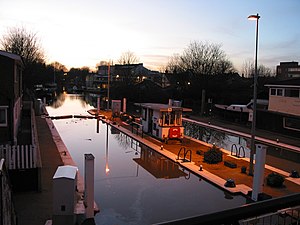
Brentford is said to be where Julius Caesar forded the Thames in his second raid on Britain.[5] This location is asserted on the Brentford Monument, and that a battle was fought here between Cæsar's forces and Cassivellaunus, King of the Trinovantes.[6] There are, however, two other historically accredited battles of Brentford in 1016 and 1642In the twentieth century a hefty stake was found in the river, possibly one of those which Roman historians report were driven into the river by the Britons to hinder the Romans. The stake forms part of the Middlesex Guildhall Collection.
In Saxon times the Church held a major synod in Brentford. In later times it prospered as a river harbour, the mouth of the Brent providing a haven on the Thames and a conduit inland for boats.
Timeline
- 54 BC Brentford is a likely site of a battle recorded by Julius Cæsar between Julius Cæsar and King Cassivellaunus.
- 781 Council of Brentford recording settlement of a dispute between King Offa of the Mercians, and the Bishop of Worcester
- 1016 Battle of Brentford between the invading Canute and Edmund Ironside
- 1431 Relocation of Syon Abbey to Brentford from Twickenham
- 1539 Dissolution of Syon Abbey by King Henry VIII
- 1616 - 1617 Pocahontas, the Native American Princess, lived in Brentford
- 1642 Battle of Brentford during the English Civil War
- 1682 A very violent storm of rain, accompanied with thunder and lightning, caused a sudden flood, which did great damage to the town of Brentford. Water covered the whole town; boats rowed up and down the streets, and several houses and other buildings were carried away by the force of the waters.[7]
- 1717 Brentford Turnpike Trust founded to maintain the road between Kensington and Hounslow
- 1805 Start of operations of the Grand Junction Canal (later the Grand Union Canal)
- 1828 William Corder was arrested on Wednesday April 23 at Everley Grove House, Ealing Lane in Brentford, for the notorious Red Barn Murder.
- 1841 Brentford was flooded, caused by the Brent Reservoir becoming overfull so that the overflow cut a breach in the earth dam. Several lives lost.[8]
- 1849 Start of operations of the Hounslow Loop Line, providing service to Kew Bridge, Brentford Central and Syon Lane stations in the Brentford area.
- 1859 Start of operations of the Great Western & Brentford Railway company linking Brentford Dock to the Great Western Railway main line at Southall. Additional passenger station named 'Brentford Town' later constructed just north of Brentford High Street.
- 1884 Start of operations of Boston Manor Underground station (then known as Boston Road).
- 1889 Brentford Football Club founded by a rowing club seeking a winter sport.
- 30 May 1925 - Great West Road officially opened by King George V. Later the Brentford section became known as the Golden Mile due to the large number of factories that relocated there to take advantage of the good communications. The factories provided high employment and stimulation to the local economy.
- 1 January 1929 - Grand Junction Canal bought by the Regent's Canal and amalgamated with other canals to form the Grand Union Canal.
- 1965 Opening of elevated section of M4 motorway
The road which is now Brentford High Street served as the main road to the South West of Britain for many centuries, and even now, the M4 motorway and the Great West Road pass approximately a mile north of the original main road through Brentford.
The Hardwicks
A notable family from Brentford was the 18th/19th century architectural father and son partnership, the Hardwicks. Thomas Hardwick Senior (1725–1798) and Thomas Hardwick Junior (1752–1829) were both from Brentford and are buried in the old church of St Laurence. Hardwick Senior was the master mason for the Adam Brothers during the construction of Syon House. Hardwick Junior assisted in the building of Somerset House and was known for his designs of churches in the capital. He was also a tutor of J.M.W Turner whom he helped start Turner's illustrious career in art. Both father and son did a great deal of remodelling and rebuilding on the church of St Laurence.
Places of interest
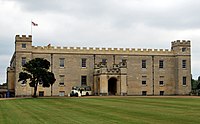
Syon House and Park
Syon House was the London residence of the Duke of Northumberland.
Syon Abbey, now razed to the ground, was the largest abbey church in England. Syon House is built upon part of the site of Syon Abbey. The exact location of Syon Abbey was unknown until archeological investigations in the grounds of Syon House (Syon Park) in 2003 by “Time Team” and 2004 revealed the foundations of the abbey church. It was larger than Westminster Abbey is now, but no above-ground structure remains. For more details on the abbey and the reasons for its destruction, see its own entry - Syon Abbey.
The London Butterfly House in Syon Park was an insectarium like a large glasshouse containing a butterfly zoo. Visitors could see butterflies and moths flying about, feeding, and emerging from chrysalises. There was also a colony of large ants (kept with the butterflies), a small tropical bird aviary, and a small gallery of reptiles, amphibians, insects and spiders. The lease on the current site expired in Oct 07 and the Butterfly House closed on 28 October 2007.
Others
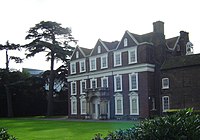
Boston Manor House, built in 1622, is a Jacobean manor house, noted for its fine plasterwork ceilings.
Gunnersbury Park Museum is the local museum for the Boroughs of Ealing and Hounslow and situated in Gunnersbury House. It contains many archaeological finds including hundreds of flints, and Roman and Viking weapons found in Brentford. It also has displays of costumes and changing displays on other subjects of local interest. The house was formerly occupied by the Rothschild family and although they did not leave any contemporary furniture or fittings, some of the decorative schemes have been well preserved.
The Weir, public house, formerly 'The White Horse' was where the artist J M W Turner lived for one year at the age of ten. He is regarded as having started his interest in painting while living there. Later on in life, he lived nearby in Isleworth and Twickenham.
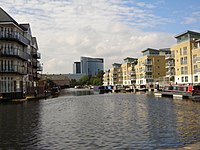
Syon Park House (demolished in 1953), not to be confused with Syon House, housed the 'Syon Park Academy' where the poet Shelley was educated between the ages of 10 and 12 before moving on to Eton College. A Royal Mail depot stands on the site now. This may also be the site of the dwelling where Pocahontas lived in Brentford End between 1616 and 1617.
Brentford Dock, a freight terminus of the Great Western Railway, built at the confluence of the River Thames and River Brent, designed by Isambard Kingdom Brunel, and built between 1855 and 1859. A spur line from the GWR at Southall was constructed to the Brentford Dock railway station to facilitate easy transferral of freight from lighter (barge)|lighters and barges on the Thames to GWR-served destinations in the west of the United Kingdom. The dock was redeveloped as residential accommodation in the early 1970s, and little industrial archaeology remains. However, Dock Road still retains some of its original fan pattern cobblestone road bed and examples of Brunel's broad-gauge 'bridge section' rail can be seen there.
The Brentford Dock flats (Originally named the Tiber Estate[9])were built alongside formerly important transport infrastructure as Brentford is the terminus of the Grand Union Canal, originally the Grand Junction Canal. This waterway is still in use for leisure traffic.
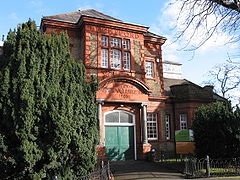
Brentford Public Library is a Carnegie library.
Brentford Public Baths (1896) are a Grade II listed example of late Victorian architecture.
Kew Bridge Steam Museum houses the world's largest working beam engine.
The Musical Museum houses a large collection of mechanical musical instruments, such as player pianos.
Griffin Park is home to Brentford Football Club and Chelsea Football Club Reserves (from 2002 until 23 September 2005 it was the home of the London Broncos rugby league club - subsequently they were renamed Harlequins Rugby League and transferred to The Stoop).
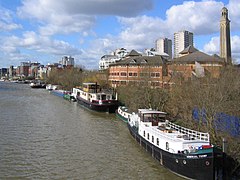
Outside links
| ("Wikimedia Commons" has material about Brentford) |
- Syon Park and House
- Boston Manor Park
- Brentford's local website
- Brentford Dock residents' website
- ‘’'Brentford', The Environs of London’’: volume 2: County of Middlesex (1795), pp. 39-58 - British History On-line
- Brentford, Chiswick & Isleworth Times online
- Kew Bridge Steam Museum
- The Musical Museum
- Gunnersbury Park Museum
- Museum of London page on the Brentford horn-cap showing the 'Brentford Knot' pattern
- Thomas Layton & his Collection
- The Gillette Building, Brentford
- Amateur local history website on Brentford
- Brentford High Street project: people and properties 1840 - 1940
References
- ↑ 'Ealing and Brentford: Growth of Brentford', A History of the County of Middlesex: Volume 7: Acton, Chiswick, Ealing and Brentford, West Twyford, Willesden (1982), pp. 113-20 accessed: 30 May 2007
- ↑ Encyclopedia Britannica, 1911 Edition
- ↑ http://www.museumoflondon.org.uk/archive/lbl/pages/moreObjResult.asp?id=4542&code=O1760&terms=horn+cap&search=&whichobj=&go=Go museumoflondon.org.uk
- ↑ http://www.museumoflondon.org.uk/archive/lbl/pages/toursCollectors1.asp museumoflondon.org.uk
- ↑ Sir Montagu Sharpe
- ↑ The Thomas Layton Collection, Inscription on the Brentford Monument
- ↑ Brentford, The Environs of London: volume 2: County of Middlesex (1795), pp. 39-58. . Date accessed: 18 August 2007.
- ↑ Defra:Foods and reservoir safety integration Vol 2: Appendix D pg 34. Accessed 2007-08-21
- ↑ "History of the Docks, Brentford". http://brentford.inuk.com/bd.htm. Retrieved 2008-01-07.
- The Archive Photographs Series, Brentford; Tempus Publishing Ltd., 1998, ISBN 0-7524-0627-2
- Brentford as it was; Hendon Publishing Co. Ltd., Second impression May 1993, ISBN 0-86067-082-1
- Brentford Past; Historical Publications Ltd., ISBN 0-948667-79-6
- Old Ordnance Survey Maps, Brentford 1894, The Godfrey Edition; Alan Godfrey Maps, ISBN 0-85054-509-9
